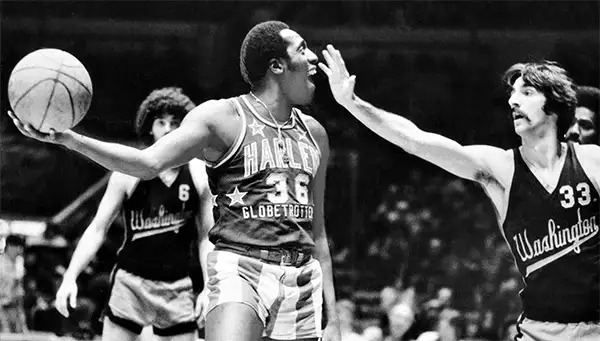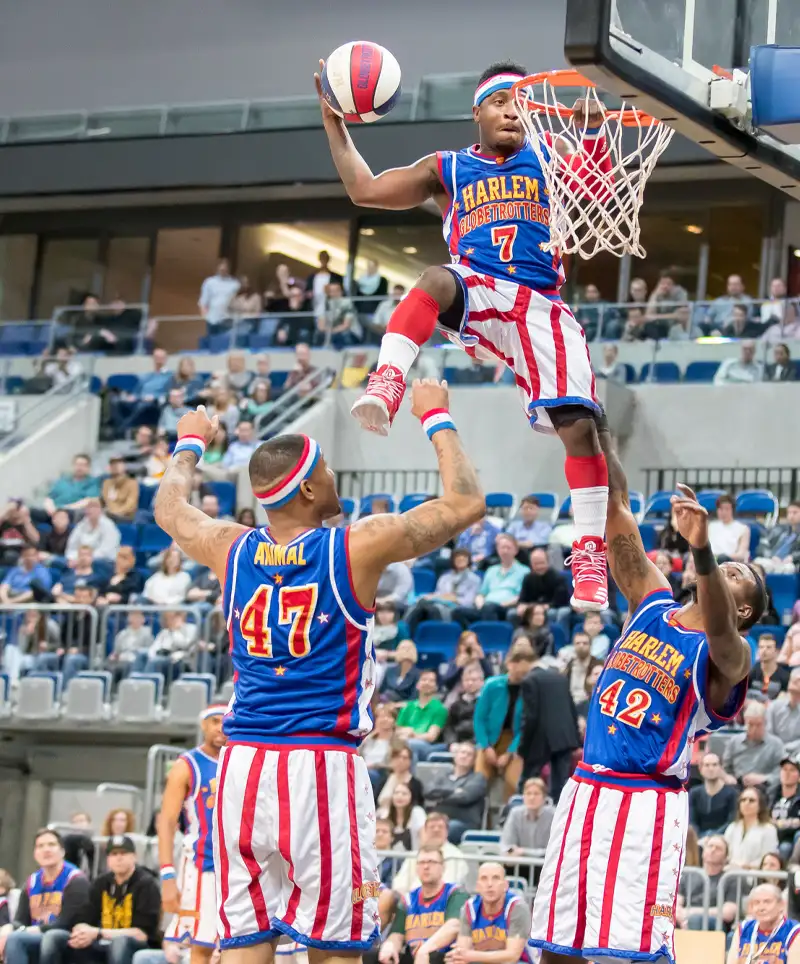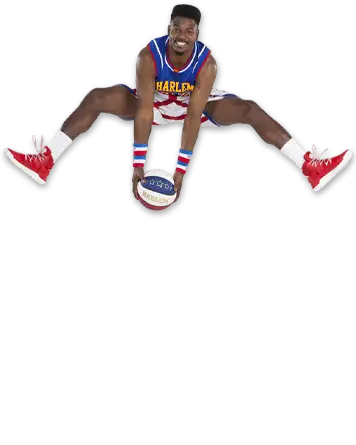Harlem Globetrotter’s Day celebrated with a slam dunk of joy each January 7th, is not your average commemorative day. It’s a whirlwind of basketball wizardry, a symphony of sneakers on hardwood, and a masterclass in mirth that honors the legendary Harlem Globetrotters. This day is to basketball what peanut butter is to jelly – an utterly perfect match!
From their inception in the 1920s, the Globetrotters turned the basketball court into a stage, the game into a show, and sportsmanship into an art form. Think of them as the Beethoven of basketball, only instead of a baton, they wielded a spinning basketball to conduct their symphony of hoops and hilarity. And let's not forget their uniform – because nothing says 'serious athlete' quite like donning a pair of star-spangled shorts and going toe-to-toe with a team that has no idea they’re part of the comedy routine!
Celebrating this day is akin to honoring the jesters of the court – the court being one with a three-point line and a hoop. The Harlem Globetrotters didn’t just play basketball; they reinvented it, turning dribbling into a dance and free throws into an opportunity for slapstick. So, on Harlem Globetrotter’s Day, we don’t just tip our hats to these pioneers of the parquet; we toss them high in the air, hoping they spin as wildly and wonderfully as a Globetrotter's basketball.
A Twist on Basketball
The story of the Harlem Globetrotters begins not in Harlem but in the Windy City of Chicago during the Roaring Twenties. It’s a bit like finding out your favorite New York cheesecake was actually baked in New Jersey. The team was the brainchild of Abe Saperstein, a man whose vision for basketball involved more spinning balls than a circus juggler.
Saperstein named them after Harlem because, at the time, Harlem was as synonymous with African-American culture as peanut butter was with jelly (again, a perfect pairing). It was a marketing masterstroke, like calling a band the "London Beatles" even though they're from Liverpool. The 'Harlem' Globetrotters were set to represent the cultural and athletic prowess of the African-American community, and boy, did they deliver!
Their early games were less about scoring points and more about dropping jaws. Picture this: five players weaving around the court as if they were part of a Broadway chorus line, but instead of high kicks, they had high dribbles. They brought a new rhythm to basketball – a rhythm so catchy it made the Charleston look like a slow waltz.
The Globetrotters played like they had just read the rulebook and decided it was more of a suggestion. Who needs a straightforward pass when you can bounce the ball off your teammate's forehead? Why simply shoot a basket when you can spin the ball on your finger, do a little dance, and then sink it? Every game was an unscripted comedy sketch, with the basketball as the punchline.
In these early days, the Harlem Globetrotters were not just playing basketball; they were redefining it. They infused the game with a sense of joy and playfulness that was as refreshing as a cool breeze on a hot New York summer’s day (in Chicago, of course). They were the court jesters of basketball, turning every game into a laugh fest – and the audience couldn’t get enough.
So, when we talk about the origins of the Harlem Globetrotters, we're not just talking about a basketball team; we're talking about the birth of a phenomenon. A phenomenon that would go on to make the world its stage, proving that sometimes, the best way to take something seriously is to have a little fun with it.
A Legacy of Laughs and Loops
The legacy of the Harlem Globetrotters is as colorful and unpredictable as a game of H-O-R-S-E with a contortionist. It's a tapestry woven from the threads of humor, athleticism, and sheer audacity.
 Let's start with the unforgettable Meadowlark Lemon, the “Clown Prince” of basketball. Lemon could have made a statue chuckle with his on-court shenanigans. He was like the Shakespeare of basketball comedy – if Shakespeare could nail half-court hook shots while cracking jokes. And then there was Curly Neal, whose bald head was as shiny as his ball-handling skills. Neal could dribble as if the basketball was on a string, and a sorcerer controlled his string.
Let's start with the unforgettable Meadowlark Lemon, the “Clown Prince” of basketball. Lemon could have made a statue chuckle with his on-court shenanigans. He was like the Shakespeare of basketball comedy – if Shakespeare could nail half-court hook shots while cracking jokes. And then there was Curly Neal, whose bald head was as shiny as his ball-handling skills. Neal could dribble as if the basketball was on a string, and a sorcerer controlled his string.
But it wasn't all jest and japes. The Globetrotters were also masters of the gravity-defying dunk – the kind that made fans wonder if they had secret wings tucked into their jerseys. Their slam dunks didn’t just defy gravity; they made gravity sit in the corner and think about what it had done. And let’s not forget those half-court trick shots. Each shot was like a mini-drama, complete with suspense, awe, and a triumphant finale that often left the crowd as dizzy as the spinning ball.
The Globetrotters' legacy also extended beyond the court. They were like basketball diplomats, spreading goodwill with each bounce of the ball. Their tours around the world were not just about showcasing their skills but also about connecting cultures. In countries where basketball was as foreign as a quiet mime, the Globetrotters introduced the game with the universal language of laughter and awe-inspiring athleticism.
Today, the legacy of the Harlem Globetrotters continues to echo through every alley-oop and behind-the-back pass in professional basketball. They showed the world that basketball could be more than a game – it could be an art form, a source of joy, and a bridge between cultures. On Harlem Globetrotter’s Day, we don’t just remember the laughter and the loops; we celebrate the enduring impact of a team that turned basketball into a symphony of fun and flair. They were not just players; they were the maestros of merriment, the virtuosos of the court, conducting a concert where every dunk, dribble, and trick shot was a note in their playful melody.
More Than Just Tricksters
The Harlem Globetrotters, often celebrated for their dazzling ball-handling skills and comedic antics, hold a much more profound place in the annals of basketball history than many realize. Their significance stretches beyond the hardwood floors of basketball courts into the very fabric of social change and racial integration in sports.
In an era when segregation and racial discrimination were rampant, the Harlem Globetrotters were shattering stereotypes and breaking down racial barriers. Their landmark victories against the Minneapolis Lakers in 1948 and 1949 were not just wins in a game; they were powerful statements against racial inequality. These matches were pivotal in changing the perception of African American athletes, proving that skill and talent know no color. The victories were a beacon of hope and a source of pride for the African American community and were instrumental in the eventual integration of the National Basketball Association (NBA).
The Globetrotters also served as unofficial ambassadors of goodwill. Their international tours, which began in the 1950s, were more than just basketball exhibitions. They were cultural exchanges that introduced many parts of the world to both the sport and American culture. In countries torn by war, poverty, or political strife, the Globetrotters brought laughter and a temporary escape from the hardships of daily life. Their visits often transcended the game, as they engaged in community activities, visited hospitals, and interacted with fans from all walks of life.
The influence of the Harlem Globetrotters extends into the very essence of basketball. They were innovators, introducing a flair and style to the game that was previously unseen. Their unique blend of athleticism, theater, and comedy not only changed how basketball was played but also how it was perceived by the public. It was no longer just a competitive sport; it became a form of entertainment that could captivate and delight audiences worldwide.
Moreover, their impact on society resonates beyond the realm of sports. By challenging the status quo and showcasing excellence in the face of adversity, they inspired generations. Young athletes, especially those from marginalized communities, saw in the Globetrotters a symbol of hope and a testament to the fact that success and recognition were attainable regardless of one's background.
Today, the legacy of the Harlem Globetrotters as more than just tricksters lives on. Their contributions to both basketball and the broader social context continue to be celebrated and remembered. Harlem Globetrotter’s Day is a fitting tribute to this legacy – a day to honor not just their skill and showmanship but their role in shaping a more inclusive and equitable world through the unifying power of sports.
How do we celebrate this day? By embodying the spirit of the Globetrotters, of course! This involves engaging in community basketball games, attempting trick shots in local courts, and sharing memorable Globetrotter highlights. Schools and community centers often host events where the focus is on fun and inclusivity, reflecting the Globetrotters' ethos.
An Everlasting Impact
The Harlem Globetrotters are not just a team; they are a cultural phenomenon. They have brought joy and laughter to millions, transcended sporting barriers, and left an indelible mark on the world of basketball. Harlem Globetrotter’s Day is not just about celebrating their past achievements; it's about appreciating the joy and unity that they continue to bring into the world through the universal language of basketball and humor.
Harlem Globetrotter’s Day is a day to celebrate the blend of sports and entertainment, the breaking of racial barriers, and the universal appeal of laughter and joy. It’s a day when we remember that sometimes, a game is more than just a game – it can be a powerful tool for change, unity, and widespread smiles. So, let’s grab our basketballs, don our red, white, and blue, and give a nod to the team that taught us the true art of dribbling and the power of a well-placed joke on the court!
Please Share our Content






 Let's start with the unforgettable Meadowlark Lemon, the “Clown Prince” of basketball. Lemon could have made a statue chuckle with his on-court shenanigans. He was like the Shakespeare of basketball comedy – if Shakespeare could nail half-court hook shots while cracking jokes. And then there was Curly Neal, whose bald head was as shiny as his ball-handling skills. Neal could dribble as if the basketball was on a string, and a sorcerer controlled his string.
Let's start with the unforgettable Meadowlark Lemon, the “Clown Prince” of basketball. Lemon could have made a statue chuckle with his on-court shenanigans. He was like the Shakespeare of basketball comedy – if Shakespeare could nail half-court hook shots while cracking jokes. And then there was Curly Neal, whose bald head was as shiny as his ball-handling skills. Neal could dribble as if the basketball was on a string, and a sorcerer controlled his string.








 "Sláinte!" is a traditional Irish expression used as a toast, equivalent to "Cheers!" in English.
"Sláinte!" is a traditional Irish expression used as a toast, equivalent to "Cheers!" in English.